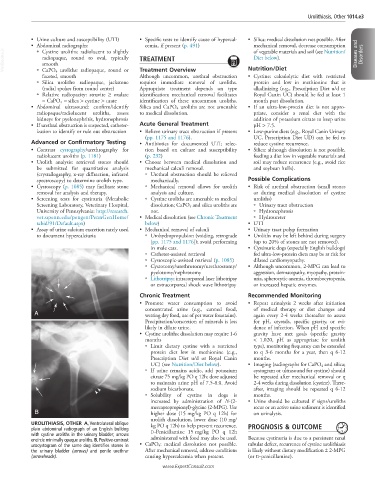Page 2031 - Cote clinical veterinary advisor dogs and cats 4th
P. 2031
Urolithiasis, Other 1014.e3
• Urine culture and susceptibility (UTI) • Specific tests to identify cause of hypercal- • Silica: medical dissolution not possible. After
• Abdominal radiographs: cemia, if present (p. 491) mechanical removal, decrease consumption
VetBooks.ir radiopaque, round to oval, typically TREATMENT Nutrition/Diet Diseases and Disorders
of vegetable materials and soil (see Nutrition/
○ Cystine uroliths: radiolucent to slightly
Diet below).
smooth
○ CaPO 4 uroliths: radiopaque, round or
faceted, smooth Treatment Overview • Cystine: calculolytic diet with restricted
Although uncommon, urethral obstruction
○ Silica uroliths: radiopaque, jackstone requires immediate removal of uroliths. protein and low in methionine that is
(radial spokes from round center) Appropriate treatment depends on type alkalinizing (e.g., Prescription Diet u/d or
○ Relative radiopacity: struvite ≥ oxalate identification; mechanical removal facilitates Royal Canin UC) should be fed at least 1
= CaPO 4 = silica > cystine > urate identification of these uncommon uroliths. month past dissolution.
• Abdominal ultrasound: confirm/identify Silica and CaPO 4 uroliths are not amenable • If an ultra-low-protein diet is not appro-
radiopaque/radiolucent uroliths, assess to medical dissolution. priate, consider a renal diet with the
kidneys for pyelonephritis, hydronephrosis addition of potassium citrate to keep urine
• If urethral obstruction is suspected, catheter- Acute General Treatment pH > 7.5.
ization to identify or rule out obstruction • Relieve urinary tract obstruction if present • Low-purine diets (e.g., Royal Canin Urinary
(pp. 1175 and 1176). UC, Prescription Diet UD) can be fed to
Advanced or Confirmatory Testing • Antibiotics for documented UTI; selec- reduce cystine recurrence.
• Contrast cystography/urethrography for tion based on culture and susceptibility • Silica: although dissolution is not possible,
radiolucent uroliths (p. 1181) (p. 232) feeding a diet low in vegetable materials and
• Urolith analysis: retrieved stones should • Choose between medical dissolution and soil may reduce recurrence (e.g., avoid rice
be submitted for quantitative analysis mechanical calculi removal. and soybean hulls).
(crystallography, x-ray diffraction, infrared ○ Urethral obstruction should be relieved
spectroscopy) to determine urolith type. mechanically. Possible Complications
• Cystoscopy (p. 1085) may facilitate stone ○ Mechanical removal allows for urolith • Risk of urethral obstruction (small stones
removal for analysis and therapy. analysis and culture. or during medical dissolution of cystine
• Screening tests for cystinuria (Metabolic ○ Cystine uroliths are amenable to medical uroliths)
Screening Laboratory, Veterinary Hospital, dissolution; CaPO 4 and silica uroliths are ○ Urinary tract obstruction
University of Pennsylvania: http://research. not. ○ Hydronephrosis
vet.upenn.edu/pengen/PennGenHome/ • Medical dissolution (see Chronic Treatment ○ Hydroureter
tabid/91/Default.aspx) below) • UTI
• Assay of urine calcium excretion rarely used • Mechanical removal of calculi • Urinary tract polyp formation
to document hypercalciuria ○ Urohydropropulsion (voiding, retrograde • Uroliths may be left behind during surgery
[pp. 1175 and 1176]); avoid performing (up to 20% of stones are not removed).
in male cats. • Cystinuric dogs (especially English bulldogs)
○ Catheter-assisted retrieval fed ultra-low-protein diets may be at risk for
○ Cystoscopic-assisted retrieval (p. 1085) dilated cardiomyopathy.
○ Cystotomy/urethrotomy/urethrostomy/ • Although uncommon, 2-MPG can lead to
pyelotomy/nephrotomy aggression, dermatopathy, myopathy, protein-
○ Lithotripsy; intracorporeal laser lithotripsy uria, spherocytic anemia, thrombocytopenia,
or extracorporeal shock wave lithotripsy or increased hepatic enzymes.
Chronic Treatment Recommended Monitoring
• Promote water consumption to avoid • Repeat urinalysis 2 weeks after initiation
concentrated urine (e.g., canned food, of medical therapy or diet changes and
A wetting dry food, use of pet water fountains). again every 2-4 weeks thereafter to assess
Precipitation/concretion of minerals is less for pH, crystals, specific gravity, or evi-
likely in dilute urine. dence of infection. When pH and specific
• Cystine uroliths: dissolution may require 1-6 gravity have met goals (specific gravity
months < 1.020, pH as appropriate for urolith
○ Limit dietary cystine with a restricted type), monitoring frequency can be extended
protein diet low in methionine (e.g., to q 3-6 months for a year, then q 6-12
Prescription Diet u/d or Royal Canin months.
UC) (see Nutrition/Diet below). • Imaging (radiographs for CaPO 4 and silica;
○ If urine remains acidic, add potassium cystogram or ultrasound for cystine) should
citrate 75 mg/kg PO q 12h; dose adjusted be repeated after mechanical removal or q
to maintain urine pH of 7.5-8.0. Avoid 2-4 weeks during dissolution (cystine). There-
sodium bicarbonate. after, imaging should be repeated q 6-12
○ Solubility of cystine in dogs is months.
increased by administration of N-(2- • Urine should be cultured if signs/uroliths
mercaptopropionyl)-glycine (2-MPG). Use recur or an active urine sediment is identified
B higher dose (15 mg/kg PO q 12h) for on urinalysis.
urolith dissolution, lower dose (10 mg/
UROLITHIASIS, OTHER A, Ventrolateral oblique kg PO q 12h) to help prevent recurrence.
plain abdominal radiograph of an English bulldog D-Penicillamine 15 mg/kg PO q 12h PROGNOSIS & OUTCOME
with cystine uroliths in the urinary bladder; arrows
encircle minimally opaque uroliths. B, Positive-contrast administered with food may also be used. Because cystinuria is due to a persistent renal
urocystogram of the same dog identifies stones in • CaPO 4 : medical dissolution not possible. tubular defect, recurrence of cystine urolithiasis
the urinary bladder (arrows) and penile urethrar After mechanical removal, address conditions is likely without dietary modification ± 2-MPG
(arrowheads). causing hypercalcemia when present. (or D-penicillamine).
www.ExpertConsult.com

